Of all the species that fly fishermen target on the flats I think the bumphead parrotfish, or bison of the flats, might just be weirdest looking thing on the planet. These bluey green monsters roam in herds on a number of atolls in the Indian Ocean and Pacific and I liken them to the ‘bison of the flats’. Growing to well over 100lb these gentle monsters come with a pair of bolt croppers on the front end that bite through coral and could easily remove a digit if you are not careful. They use this beak to crush coral heads while hunting crustaceans which they then digest to produce fine white sand. What makes them so exciting to catch? The bumphead parrotfish is the largest fish you will find tailing on the flats and they tend to move in schools of up to 50 fish with their large bluey green flags visible for miles. They are a spooky species at the best of the times so stealth and light tackle are required, but once hooked they are incredibly powerful and tend to head for the ocean. The odds are stacked against you and it is thought that for every six to eight you hook you might land one which can be incredibly frustrating…. but that is the challenge!
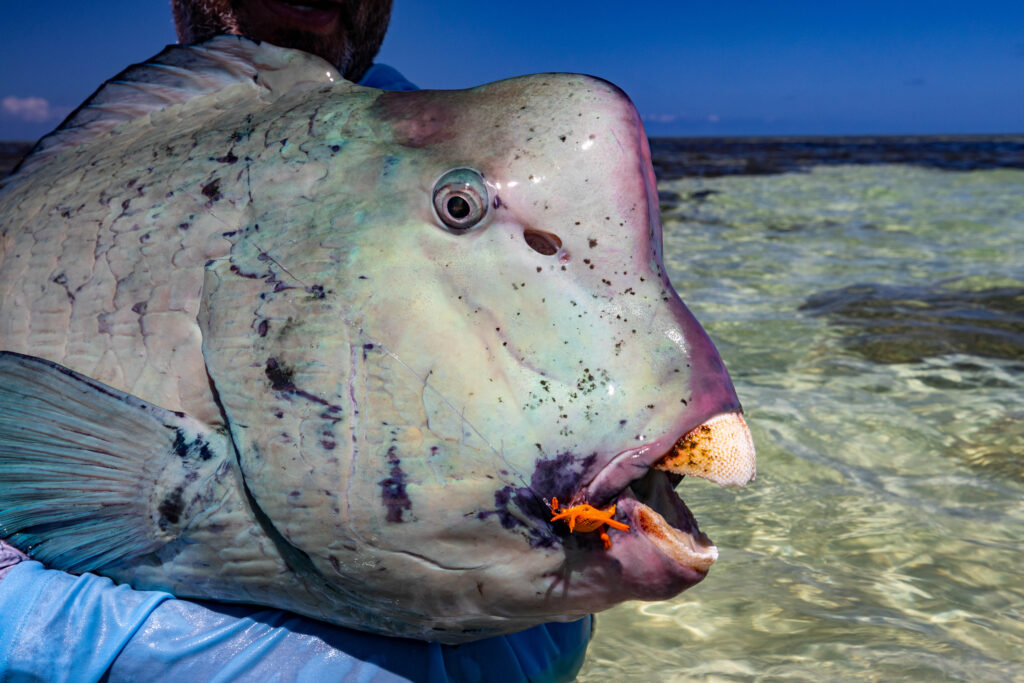
When tales of these massive beasts being caught on fly first emerged from Farquhar Atoll in the Seychelles, the fishing community was pretty sceptical that they ate crabs and that most were foul hooked – a little like milkfish. I can dismiss this as I have seen it with my own eyes, bumpies tracking off the school, tilting over sideways to eyeball a tasty morsel and then eat it. Things have also come a very long way since then on the approach and tactics when dealing with these densely packed schools which I will come onto later.
The best place to target bumpies are huge open grass turtle flats. You will see them playing in the surf line amongst the coral heads waiting to come onto the flats and occasionally they will tail around coral bommies. If you were to hook one here your chances of landing one are very slim as your line will be cut on the coral almost immediately. They are also fond of gravel bottoms that seems to make them relaxed, especially those found in the middle of turtle grass areas. The best spots are these massive expenses of turtle grass such as those found on Providence or Farquhar Atoll in the Indian Ocean where they can spend the day lazily moving along in the herd, grazing as they go.
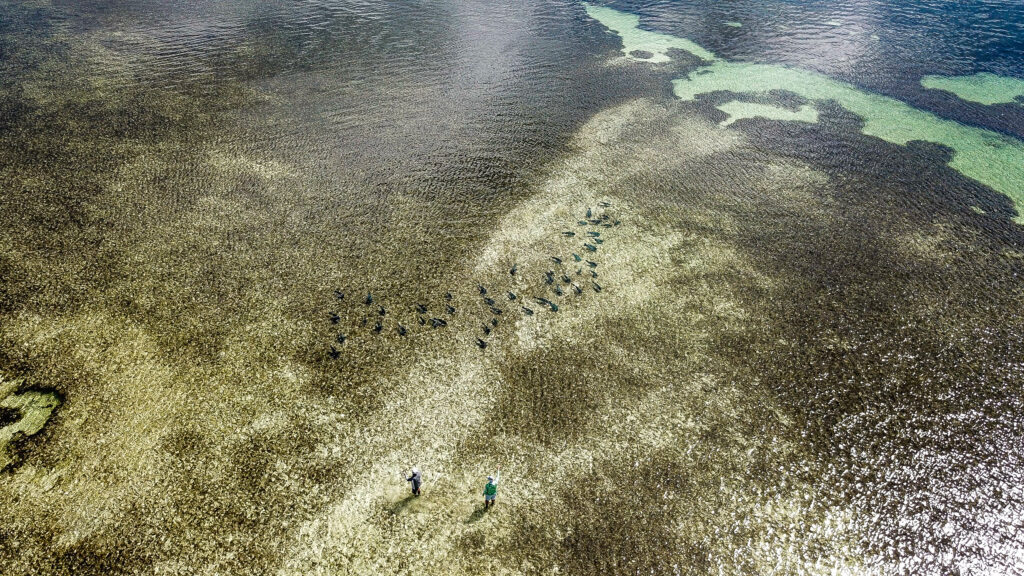
The set up for bumpies are normally nine and ten weight rods. More are caught on nine weights predominantly as that is what fishermen tend to be carrying on those flats, interchanging with their 12 weight for GTs. The modern nine weights such as the Hardy Zephrus work well as they have the power to withstand such a battle but still have the finesse of presentation. If you are out to target them specifically to the exclusion of other species then I would recommend a 10 weight. They are a big powerful fish so the added backbone will be appreciated as it heads for the ocean. Any bigger than a 10 weight and the presentation will be too rough and might spook them. The only time I changed this was targeting them in Sudan when the school were all well over 100lb and they were on the edge of the reef. In this instance not even a 12 weight could stop the fish when it ran and the entire episode ended in tears quite quickly.
On the reel front it’s imperative that you have a reel with really smooth start up inertia as when hooking these tanks on light tackle you are going to be on light tippets. Bumpies can be line and leader shy which somewhat adds to the complicated equation. Ideally your tippets should be 40 lbs fluorocarbon. If the fish are spooky the guides will often make you scale down to as little as 20 lbs. These days we use furled leaders for bumpies for several reasons. The furled leader picks up a lot of the shock as well as providing extra abrasion resistance for the harsh habitat you are fishing in. Alternatively tapered permit leaders will suffice to a 20 lbs point minimum. Again, fluorocarbon works best as it is harder for the fish to see whilst providing a little more resistance against those big choppers.
Leaders are connected to the fly line with the standard loop to loop connection. When it comes to fly lines, floating lines only, and pick one with a long belly and gentle front taper. Good turn over matched with as subtle a presentation as possible is the way forward.
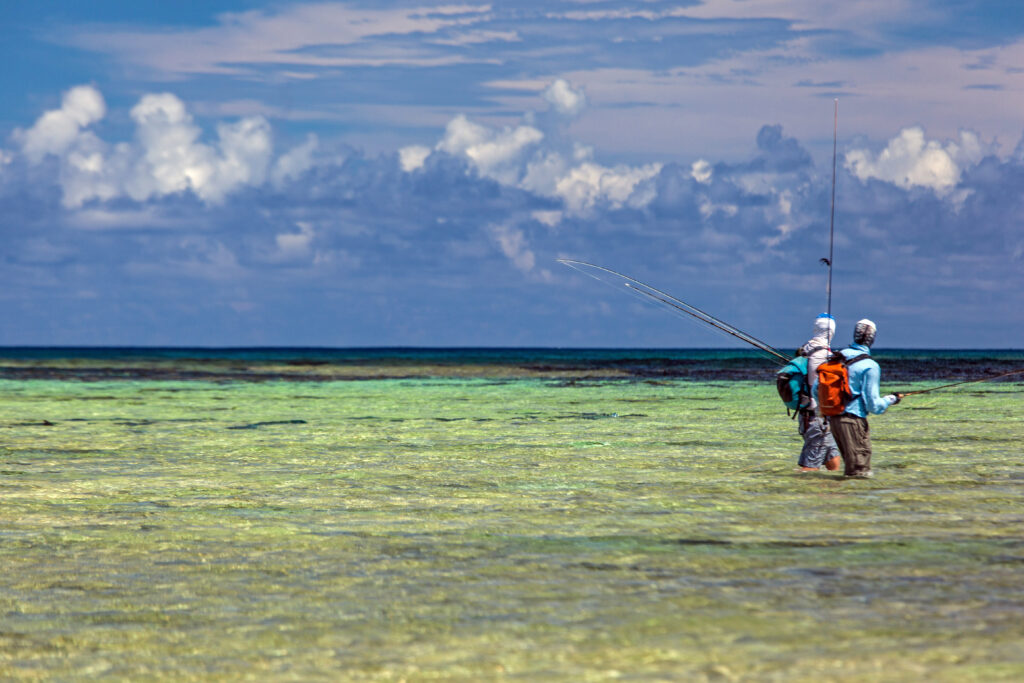
When it comes to choosing flies to cast at these behemoths, there are two aspects that are vital. The first is a REALLY strong hook. If you think triggerfish mess up hooks its nothing compared to these guys. Owners and Gamakatsu SL12s work well. Due to their mouth structure of beak and not much gum, hooking them is complicated, so a hook with a nice big gape helps. The second aspect is that all your flies need to have a weed guard as the areas you fish dictate you will get hooked up all the time on turtle grass or coral. The weed guard will avoid you becoming very frustrated as well as preventing you foul hooking other fish in the school. Weed guards need to be 25-30lb Masons hard mono coming back to the hook point tied in behind the eye. Weight is also key and depth of water will dictate this. Ideally a medium weight dumbbell, as the large dumbbell eyed flies will spook the fish on entry into the water. You tend to find yourself fishing in knee to mid-thigh depth water. The shallower the water, scale down the weight, common sense in saltwater anyway. In terms of patterns, white Merkin patterns and white Flexo Crabs have proved to be the most effective. Tan works as well, but the white flies have better contrast with the turtle grass. The bumpy is a visual creature so the fly needs to pop.
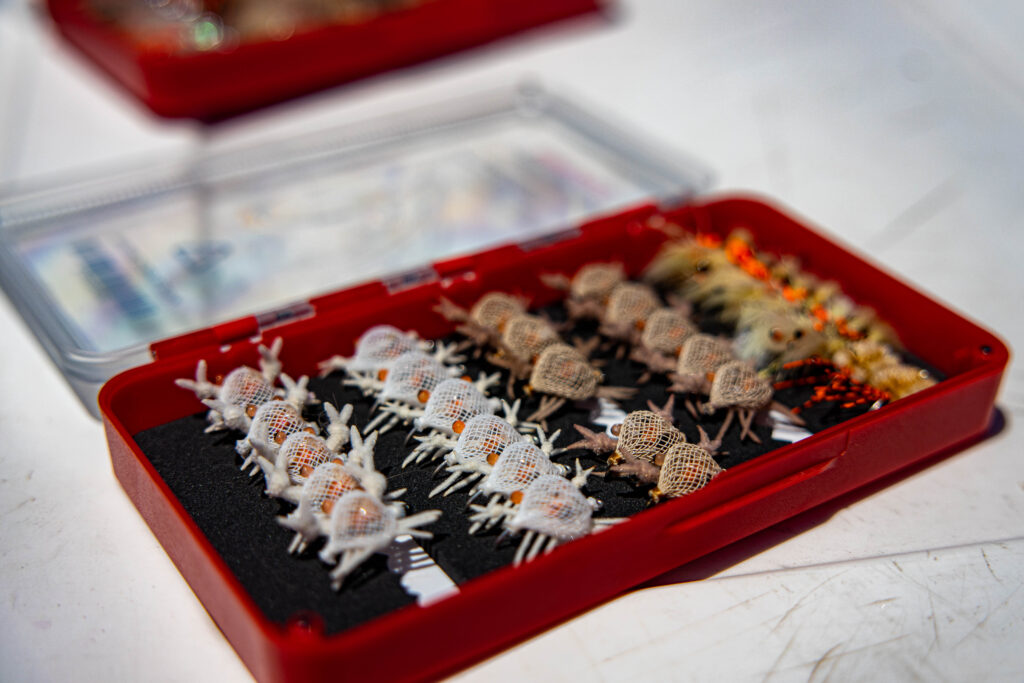
When it comes to tidal phases, bear in mind the size of the fish, so when thinking about which tides are best you need to consider their need to maintain energy. These fish don’t wish to be swimming in a strong current as they will expend too much energy. Neap tides are therefore preferable and they like the slack water when they can spend lots of the time on the flats. Spring tides will require more energy to remain in the area they like. I think my favourite, if I had the choice, would be neap tides on a new moon cycle. The full moon cycle can be very good, but there seem to be times when they vanish from the flats. This could be something to do with a spawning cycle but we still know very little about them. What we have learnt has come from guides’ time on the flats with trial and error based on observations.
When it comes to presenting the fly, a huge amount depends on your ability to anticipate where they will move to. We don’t strip the fly. The fly sits in the line they are moving in and the fisherman just maintain tension on the fly. This sounds simple, but when a school is bearing down on you and you have a current pushing across the flat, keeping in contact with the fly can be a challenge. The true skill in hooking a bumpie comes in anticipating that line of movement and putting the fly in the right spot. The guides I have fished with on Providence and Farquhar have this dialled in. I will warn you now though that bumpies can be the most frustrating fish. You could hook many in a day and not land one to come home with your tail between your legs. Be prepared.
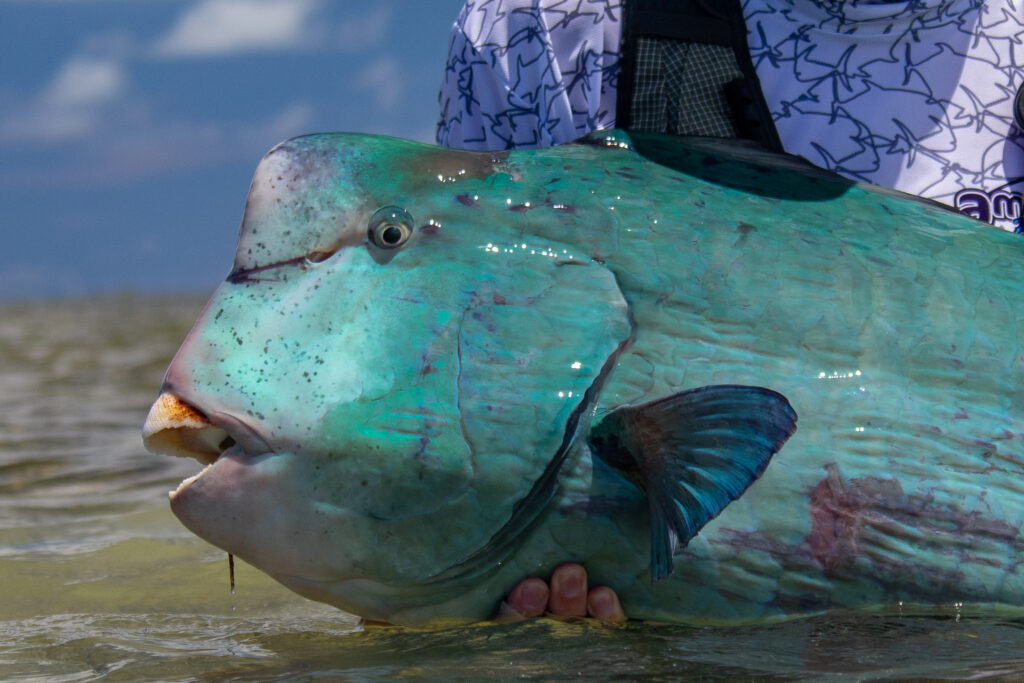
I remember one incredible afternoon on the east side of Providence Atoll several years ago where there were at least four massive schools tailing across this one giant turtle grass flat. We hooked many, and myself and one of the other fisherman managed to land one each, so we were ecstatic. The third fisherman with us proceeded to hook eight in succession and each time something went wrong. We followed him along the flat passing him rods with new leaders and flies rigged, a bit like a production line – to have them destroyed and passed back. We were running out of crab flies when finally, as the sun was slipping down the sky, he hooked one last fish. The battle was immense as it took us all the way to the edge of the flat before our guide finally waded out to chest depth and manged to net it. The jubilation was immense as our team returned to the mothership that night. But I digress…
So you have arrived on the flats to be greeted by big flopping bluey green tails. As we touched on earlier the approach is vital. You need to approach in the right direction and if you get this wrong it can dramatically reduce your chances of hooking one. If they are moving from the deep water to the shallow, you need to get high on the flat from the shallow section and present the fly down to them. It’s a bit like feeding a fly down stream to an ultra spooky trout. This allows the school to move up on the fly without spooking them. Essentially it is an ambush presentation. In an ideal world you want to present the fly from directly head on. Presenting from the side on means you are increasing the chance of lining them, foul hooking one, and if you do hook one it increases the chances of being cut off by another fish in the school. Think of it as trying to swim your line through a parade of wire cutters. It’s so much better to feed them head on and allow them to come up onto the fly. Often they will feed past you and frustrated fishermen will try and fish from behind. The chances of hooking one this way are very small. It’s far better to relocate and move round to the front again. You don’t want to be presenting from the wrong angle.
When the fly has been cast out to the ambush point you must let it to sink. Pick up all the slack line and just maintain tension so that you can feel if a fish picks the fly up. If you feel your fly is out of position to where the school is moving then you can strip it into position or recast, but then allow the fly to sink again. Don’t strip it over their heads or you will spook them.
You have presented the fly correctly, the fish picks up the fly and now what happens? It’s vital you remember that you are fishing a thin gauge hook on light leaders and not a GT rig, so make sure you don’t GT strip set or you will pop the leader straight away. This often happens to fishermen who have been fishing for GTs all week.
As soon as the hook is set then all hell breaks loose. The school tends to explode and move off together like the proverbial stampeding herd of bison. Clear the slack line onto the reel as if it hooks up on anything it will smash off immediately. Once the fish is on the reel and taking line, then take a minute to become aware of what is around you on the flat. This will prevent you falling into white holes or deeper water… like I have in the past! Once he is on the reel fishermen can get spooked as the fish has stripped off 150 yards of line and just keeps going. Don’t be tempted to change the drag or you will pop the leader. It’s best to set the drag tension before you start fishing and then just leave it. Occasionally fish will run into a depression or turtle grass lip and just sit there, but most of the time they run with the school and carry on running. For the first ten minutes you will have no control at all which takes some getting used to. Once the fish tires a little you need to try and separate it from the school. Your guide will head out in front to try and keep the line clear and prevent you being cut off.
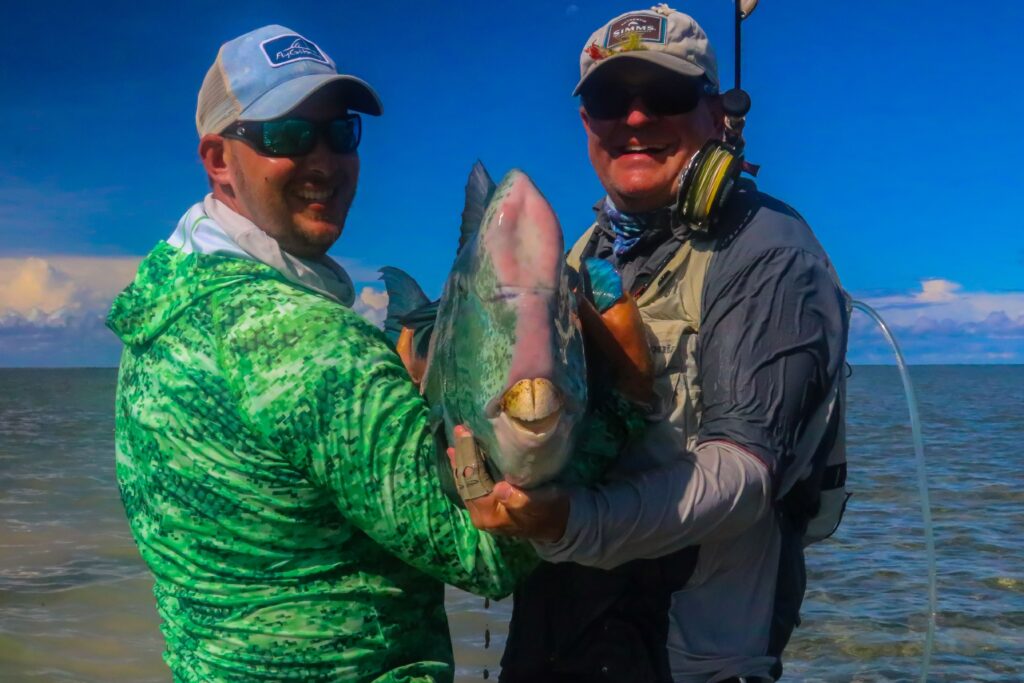
The second stage commences once it is separated from the school. Keep the rod angle high at this point as with the length of line you have out, side pressure will have no impact. Once the fish is within 30 or 40 metres you can start working angles. They are incredibly powerful fish so be patient and maintain constant pressure. The third stage comes when it is time to try and land one of these fish. It can be tense as it has normally been a pretty serious battle, especially when you have lost a few beforehand. To land a bumpy you really need a net and a big one at that! Alternatively, you can lanyard them through the beak which can sometimes require rugby tackling it on the flat. They are extremely slimy, so hard to grab and the caudal compresses providing no wrist to gain purchase on. The best way is to cradle it, but I would highly recommend you let your guide do the honours as he is going to get bullied. These fish tend to release really well as they are so strong.
The feeling of landing one of these wonderful creatures and watching it swim away again is hard to describe. I think because actually landing one proves so hard, with the odds stacked you, each fish you actually land and touch is a bit of an emotional rollercoaster. It becomes a shared experienced with those accompanying you and one you never forget. Are they the weirdest fish on the planet, probably.. are they one of the coolest to land on fly… definitely…
To learn more about these extraordinary creatures and where you can go to catch one please contact Peter McLeod, or contact the office on +44 1980 847389.
About the author: Peter McLeod
